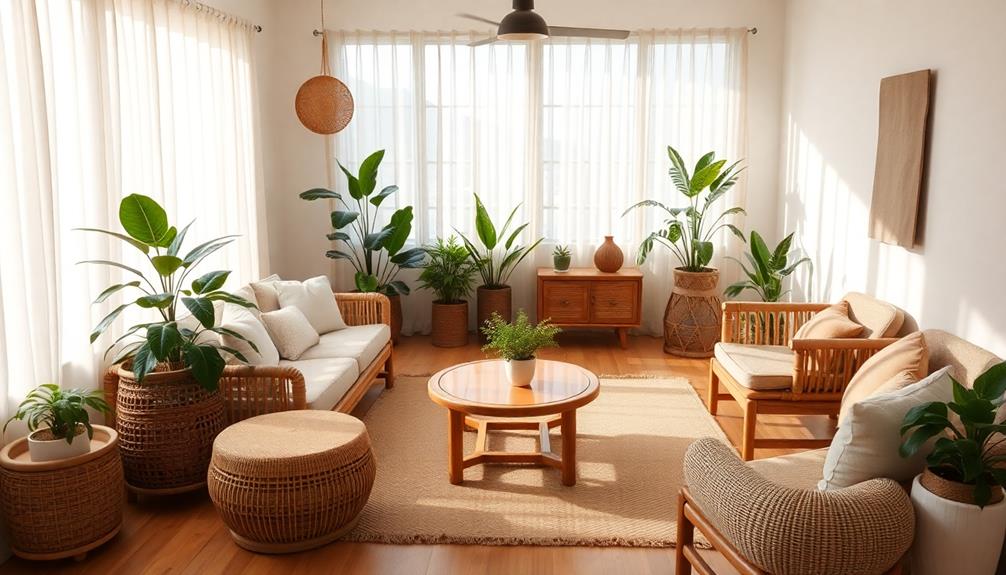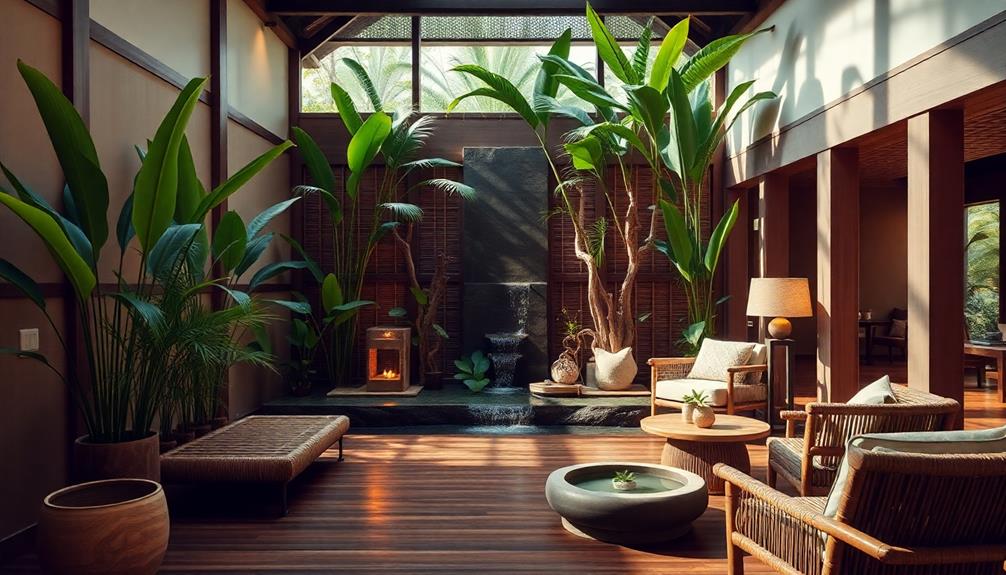Balinese interior design helps to create a calming retreat within your home by combining natural materials such as bamboo and rattan with soft, soothing colors. You can evoke a sense of peace with earthy tones, serene blues, and spacious layouts that maximize natural light and airflow. By incorporating cultural elements like handcrafted accents and water features, you can establish a peaceful ambiance. Even in smaller rooms, versatile furniture and indoor plants can enhance the overall look. By carefully selecting natural textures and colorful fabrics, you can bring the beauty of Bali indoors. There is much more to discover, so let’s delve into the details that will assist you in transforming your living space!
Key Takeaways
- Incorporate natural materials like bamboo and rattan to create warmth and texture in your space.
- Use a calming color palette of earthy tones and soothing blues to promote serenity.
- Emphasize open layouts with large windows to enhance natural light and indoor-outdoor flow.
- Add indoor plants and water features to enhance tranquility and connect with nature.
- Include handcrafted decor and cultural textiles to reflect Balinese heritage and authenticity.
Characteristics of Balinese Design

Embracing a blend of tradition and modernity, Balinese design showcases characteristics that create serene and inviting spaces. You'll find that this style merges intricate wood carvings and vivid wood panels with modern minimalist furniture, fostering a welcoming atmosphere.
The use of natural materials like bamboo, rattan, and stone not only adds warmth but also promotes a crucial connection with nature. This design philosophy encourages natural materials in decor to enhance the overall aesthetic and comfort of your home.
To achieve a tranquil atmosphere, Balinese interior design often employs earthy tones and calming blues that reflect the stunning landscapes of Bali. These muted hues enhance relaxation and contribute to a sense of peace within your living environment.
Additionally, open spaces and large windows are essential in facilitating natural light flow and seamless shifts between indoor and outdoor spaces, further promoting harmony.
Incorporating handwoven fabrics and traditional Balinese art adds an artistic flair and cultural richness to your home. Each decorative element contributes to the overall experience, making it easier for you to unwind and appreciate the beauty around you.
Essential Features for Tranquility

Creating a tranquil space in your home involves integrating essential features that embody the essence of Balinese design. Start by embracing open spaces and large windows, allowing natural light to flow freely and creating a seamless connection between the indoors and outdoors.
This connection to nature is vital for enhancing tranquility. Incorporating elements such as Indonesian decorative pillows can add vibrant colors and intricate patterns that enhance comfort and reflect cultural heritage.
Incorporate natural materials like wood, bamboo, and stone to foster a calming atmosphere. Choose a neutral color palette dominated by earthy tones, complemented by soothing blues and greens. This combination evokes feelings of serenity and well-being, making your living space a peaceful retreat.
Add indoor plants to introduce life and fresh air into your environment. The gentle sounds of a water feature, such as a small fountain, can further enhance the tranquil ambiance while improving air quality.
Opt for wooden furniture that reflects the beauty of nature and complements your aesthetic.
Implementing Balinese Style in Small Spaces

Transforming small spaces with Balinese style can be both rewarding and practical. To achieve this, focus on integrating natural materials like bamboo and rattan in your furniture and décor. These elements add warmth and texture while keeping the space feeling open.
Additionally, consider incorporating intricate carvings or traditional textiles to further enhance the aesthetic appeal and reflect local culture. Opt for multipurpose furniture, such as foldable tables and storage ottomans, to maximize functionality without sacrificing aesthetic appeal.
Incorporate greenery by adding indoor plants like ferns and palms, which enhance the tropical feel and create a tranquil haven. Pair these with traditional Balinese art pieces, like handcrafted sculptures and woven textiles, to achieve visual harmony and cultural authenticity.
For a deeper understanding of Balinese design elements, you may explore traditional Indonesian style home decor.
Consider implementing open-plan designs that utilize light colors and large windows, allowing natural light to flow freely. This approach not only creates a sense of spaciousness but also connects your indoor areas with outdoor views, enhancing the overall ambiance.
Affordable Balinese Design Solutions

For those looking to infuse their homes with Balinese design on a budget, the key lies in simplicity and resourcefulness.
Start by incorporating natural materials like bamboo and rattan, which you can often find at thrift stores. These elements help create an authentic Balinese atmosphere without breaking the bank.
Consider adding traditional artistry through decorative masks that reflect the rich cultural heritage of Indonesia.
Next, use earthy color schemes such as beige, white, and light brown to promote serenity and calmness; budget-friendly paint and fabric choices work wonders here.
Opt for multipurpose furniture that maximizes functionality in small spaces, blending comfort and practicality reminiscent of Balinese design.
Furniture that serves more than one purpose isn't only economical but also enhances your Balinese-inspired home.
Engage in DIY projects, like creating decorative pots or macramé hangings, to add personal touches while keeping costs low.
Creating Your Personal Oasis

Creating your personal oasis starts with the thoughtful incorporation of natural elements that foster a serene atmosphere. Focus on using natural materials like wood, bamboo, and stone to create a warm, inviting space that brings you closer to nature.
For inspiration, consider exploring luxury tropical design aesthetics that seamlessly blend modern luxury with nature. A calming color palette featuring earthy tones, soothing blues, and warm neutrals will evoke feelings of tranquility and peace.
To enhance your oasis, consider these key elements:
- Open-air designs: Large windows and sliding doors maximize natural light, blending indoor and outdoor spaces seamlessly.
- Indoor plants and water features: Incorporate greenery and soothing sounds, like fountains or ponds, to create a tropical vibe that promotes relaxation.
- Handcrafted decor: Select intricately carved wooden pieces and traditional textiles that reflect Balinese cultural heritage, adding authenticity and artistry to your environment.
This combination of elements not only creates a beautiful space but also guarantees your personal oasis becomes a sanctuary for relaxation and rejuvenation.
Key Materials and Textures

Incorporating the right materials and textures can elevate your personal oasis to new heights. Start with sustainable options like bamboo, rattan, and teak wood, which bring warmth and a tropical feel to your space. These natural materials not only enhance the rustic aesthetic but also create a calming atmosphere.
Additionally, luxury tropical designs often incorporate vibrant colors that can complement these natural elements beautifully.
Textures play a significant role in Balinese design. Use natural fibers, such as jute and linen, to add depth and tactile experience. Combine these soft materials with stone accents like volcanic rock or river stone to establish a harmonious connection with nature.
The contrast between smooth wooden surfaces and the rough textures of stone generates visual interest, making your decor more dynamic.
Handcrafted items are essential, too. Look for intricately carved wooden decor and traditional textiles that reflect Balinese culture and artistry. These pieces serve as focal points, drawing attention and enhancing the overall design.
When you thoughtfully combine these key materials and textures, you create a balanced and inviting environment that not only relaxes but also inspires. Embrace these elements, and your home will transform into a true Balinese sanctuary.
Integrating Cultural Elements

Embracing the rich cultural elements of Bali can truly transform your space into a vibrant reflection of the island's heritage. By integrating traditional Balinese style interior design, you can create an atmosphere that resonates with tranquility and beauty.
Incorporate natural materials like wood and textiles, such as batik and ikat, to ground your decor in authenticity. Additionally, consider including unique pieces like a Face Indonesian Decor Mask to further enrich the cultural ambiance of your home.
Consider these elements to enhance your space:
- Handcrafted wooden sculptures: Use these as focal points that honor Balinese heritage and elevate your aesthetic.
- Water features: Integrate ponds or fountains to promote harmony and reflect the island's belief in nature's importance.
- Vibrant colors: Infuse your decor with deep reds and lush greens found in Bali's landscapes to bring the island's essence indoors.
Incorporating motifs and symbols from Balinese mythology in your decor creates a narrative that connects you to this rich cultural history.
Frequently Asked Questions
What Is Balinese Interior Design Style?
Balinese interior design blends traditional and contemporary styles, using natural materials like wood and stone. It emphasizes open spaces, earthy colors, and intricate carvings, creating a serene atmosphere that promotes relaxation and connection to nature.
What Is the Balinese Home Architecture?
Did you know that over 70% of Balinese homes use natural materials? Balinese home architecture blends indoor and outdoor spaces, featuring thatched roofs, intricate carvings, and tranquil water elements, creating a serene atmosphere that connects you to nature.
What Are the Principles of Balinese Design?
Balinese design principles focus on natural materials, open spaces, and earthy colors. You'll find intricate craftsmanship, abundant greenery, and water features that create a serene atmosphere, connecting your living space with nature and promoting relaxation.
How Is a Restful Relaxed Room Created Interior Design?
To create a restful room, you weave together elements like natural light, earthy tones, and gentle textures. Incorporate greenery and low-profile furniture, inviting tranquility to flow seamlessly, like a soft breeze through open windows.
Conclusion
By blending the serene simplicity of Balinese design with your personal touch, you can transform your home into a tranquil oasis. Imagine the harmony of nature meeting modern comforts, where the calming sounds of water coexist with the warmth of wood. Embrace lush textiles alongside minimalist decor, creating a space that feels both inviting and peaceful. With a few thoughtful choices, you'll find that your home can be a sanctuary, where every corner whispers relaxation and joy. Incorporate natural elements like bamboo, stone, and greenery to further enhance the connection to the outdoors, a hallmark of this aesthetic. For more inspiration, consider exploring Balinese style home tips, such as incorporating low seating arrangements or sheer curtains to let in soft, diffused light. By thoughtfully layering these elements, you’ll achieve a perfect balance of elegance and serenity in your personal retreat.









